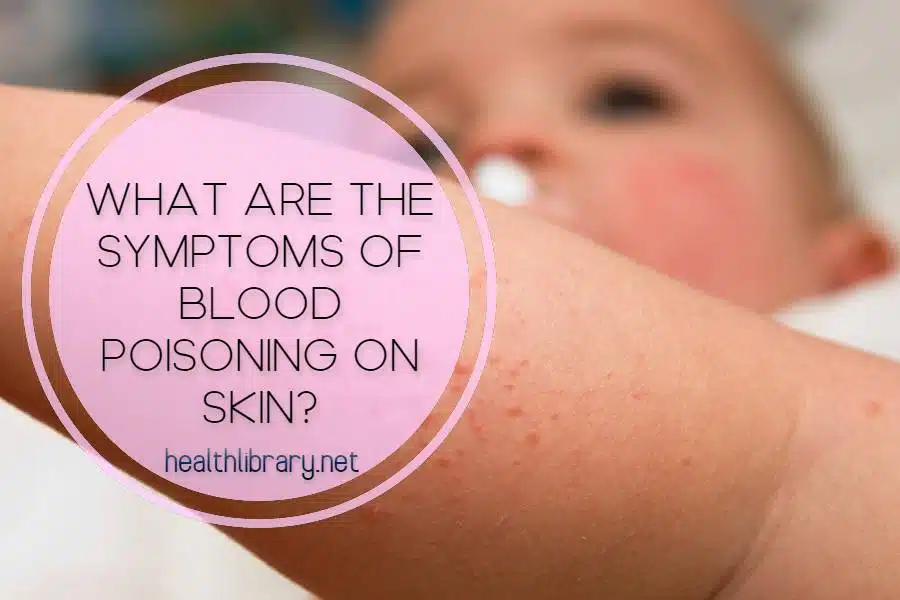Blood poisoning on skin can be a serious medical condition, often requiring urgent care. Recognizing the signs and symptoms of this condition is key to seeking prompt treatment. From raised bumps to fever, learn what symptoms to look for when it comes to blood poisoning on skin.

What is blood poisoning in humans?
Sepsis, or blood poisoning, is a potentially fatal illness that develops when an infection spreads through the circulation and affects other regions of the body.
If not treated swiftly and efficiently, it can result in organ failure, septic shock, and death. Fever, a fast pulse, low blood pressure, disorientation, and skin discoloration are all symptoms of blood poisoning.
What types of blood poisoning are there?
Sepsis and septicemia are the two most common kinds of blood poisoning.
Septicemia is a severe kind of blood poisoning caused by bacteria that is distinguished by a high temperature, a fast pulse, low blood pressure, and infection signs such as redness, warmth, and swelling at the site of infection.
Septic shock is a more severe form of septicemia in which a person’s blood pressure drops significantly, resulting in organ failure and other potentially fatal consequences.
Sepsis and septicemia are both caused by bacterial, viral, fungal, or parasitic diseases and require immediate medical attention to avoid catastrophic consequences and death.
Are blood poisoning and sepsis the same?
Yes, the terms “blood poisoning” and “sepsis” are frequently used interchangeably to describe the same illness. Sepsis is a potentially fatal response to an infection that, if not treated swiftly and properly, can result in organ failure and death.
Blood poisoning is another word for sepsis that is occasionally used in medical situations, although it is less widely used. Sepsis, by whatever name, is a dangerous illness that needs immediate medical intervention.
High fever and chills
A high temperature and chills are two of the most prevalent indications of blood poisoning on the skin. This is caused by a bacterial infection, which causes your body’s fever to rise while it battles the illness.
Seek medical assistance right away if you have a temperature of more than 100°F (37.8°C) combined with chills and other symptoms.
Muscle aches and joint pain
Severe muscular pain or pain in the back, arms, legs, or other regions of the body can also result from blood poisoning. Some patients may also have joint discomfort and swelling in places like the ankles and knees.
Muscular tension can rise as a result of a breakdown in normal cell processes while the body fights against bacterial infections caused by blood poisoning.
If you experience any sudden and unexpected musculoskeletal pains, seek medical attention as soon as possible.
abdominal pain and nausea
Abdominal discomfort, nausea, and vomiting are other signs of blood poisoning. This is due to the fact that the infection can induce swelling in the belly and other organs, resulting in severe stomach pains.
These symptoms, however, are more likely to be noticed in children who have developed sepsis as a result of an infection transmitted through the mother’s umbilical cord.
If you have significant discomfort or soreness in your abdomen, call your doctor as soon as possible.
weakness and fatigue
Two of the most typical signs of blood poisoning on the skin are weakness and weariness. This is because an illness causes your body to work harder than usual, resulting in fatigue.
Even after rest, you may notice a drop in energy and a sense of tiredness. If you have any of these symptoms, you should get medical assistance as soon as possible.
reddening of the skin with localized swelling or tenderness
Redness and swelling in a confined region are two potential signs of blood poisoning on the skin. If your skin turns red or feels sore, it might be an indication that an infection has spread beneath the surface, producing inflammation and discomfort.
The region may become heated to the touch and swollen, with lumps and bumps appearing. It is critical not to overlook skin redness or swelling and to seek medical assistance promptly if it worsens or continues.
How long does blood poisoning take to start?
The duration of blood poisoning (sepsis) depends on various factors, including the kind and severity of the underlying infection, the person’s overall health, and the function of their immune system.
In some cases, sepsis can develop quickly, even within hours of infection. In other circumstances, symptoms may not show for several days. Sepsis can also develop gradually, making it difficult to diagnose in its early stages.
If you believe you have an infection, get medical assistance as soon as possible, especially if you have a fever, feel generally ill, or have infection signs such as redness, warmth, or swelling at the location of the illness.
Sepsis should be diagnosed and treated as soon as possible to avoid major consequences and improve outcomes.
How long can you survive with blood poisoning?
The amount of time a person can live with blood poisoning (sepsis) depends on various factors, including the severity of the infection, the individual’s overall health, and the function of their immune system.
Sepsis can be life-threatening in some circumstances, leading to death within hours or days if not treated promptly. Many patients with sepsis, however, may recover and live healthy lives if they get fast and adequate medical treatment.
It is crucial to highlight that the outcome of sepsis can vary greatly and is determined by a variety of circumstances. Early detection and treatment of sepsis are critical for better results and lowering the risk of major complications and death.